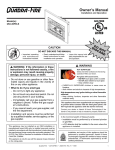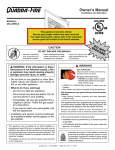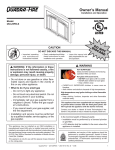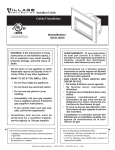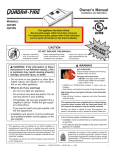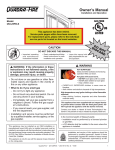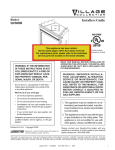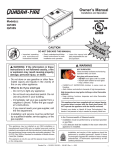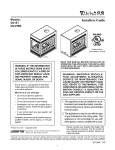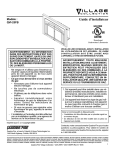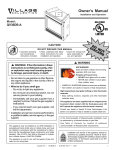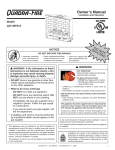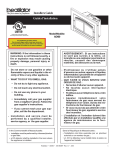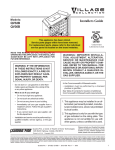Download Village QVI30 Owner`s manual
Transcript
Owner’s Manual Installation and Operation Model: QVI-30FB READ THIS MANUAL BEFORE INSTALLING OR OPERATING THIS APPLIANCE. THIS INSTALLERS GUIDE MUST BE LEFT WITH APPLIANCE FOR FUTURE REFERENCE. WARNING: IF THE INFORMATION IN THESE INSTRUCTIONS IS NOT FOLLOWED EXACTLY, A FIRE OR EXPLOSION MAY RESULT CAUSING PROPERTY DAMAGE, PERSONAL INJURY, OR DEATH. - Do not store or use gasoline or other flammable vapors and liquids in the vicinity of this or any other appliance. What to do if you smell gas • Do not try to light any appliance. • Do not touch any electrical switch. • Do not use any phone in your building. • Immediately call your gas supplier from a neighbor's phone. Follow the gas supplier's instructions. • If you cannot reach your gas supplier, call the fire department. - Installation and service must be performed by a qualified installer, service agency, or the gas supplier. WARNING: IMPROPER INSTALLATION, ADJUSTMENT, ALTERATION, SERVICE OR MAINTENANCE CAN CAUSE INJURY OR PROPERTY DAMAGE. REFER TO THIS MANUAL. FOR ASSISTANCE OR ADDITIONAL INFORMATION CONSULT A QUALIFIED INSTALLER, SERVICE AGENCY, OR THE GAS SUPPLIER. 1. This appliance may be installed in an aftermarket, permanently located, manufactured (mobile) home, where not prohibited by local codes. 2. This appliance is only for use with the type of gas indicated on the rating plate. This appliance is not convertible for use with other gases, unless a certified kit is used. In the Commonwealth of Massachusetts: • installation must be performed by a licensed plumber or gas fitter; See Table of Contents for location of additional Commonwealth of Massachusetts requirements. Printed in U.S.A. Copyright 2007 Quadra-Fire, a brand of Hearth & Home Technologies 1445 North Highway, Colville, WA 99114 Please contact your Quadra-Fire dealer with any questions or concerns. For the location of your nearest Quadra-Fire dealer, please visit www.quadrafire.com. This product may be covered by one or more of the following patents: (United States) 4593510, 4686807, 4766876, 4793322, 4811534, 5000162, 5016609, 5076254, 5113843, 5191877, 5218953, 5263471, 5328356, 5341794, 5347983, 5429495, 5452708, 5542407, 5601073, 5613487, 5647340, 5688568, 5762062, 5775408, 5890485, 5931661, 5941237, 5947112, 5996575, 6006743, 6019099, 6048195, 6053165, 6145502, 6170481, 6237588, 6296474, 6374822, 6413079, 6439226, 6484712, 6543698, 6550687, 6601579, 6672860, 6688302B2, 6715724B2, 6729551, 6736133, 6748940, 6748942, 6769426, 6774802, 6796302, 6840261, 6848441, 6863064, 6866205, 6869278, 6875012, 6880275, 6908039, 6919884, D320652, D445174, D462436; (Canada) 1297749, 2195264, 2225408, 2313972; (Australia) 780250, 780403, 1418504 or other U.S. and foreign patents pending. Quadra-Fire • QVI-30FB • 2020-900 Rev. H • 9/07 1 SAFETY AND WARNING INFORMATION ! ! ! ! ! ! ! ! ! 2 READ and UNDERSTAND all instructions carefully before starting the installation. FAILURE TO FOLLOW these installation instructions may result in a possible fire hazard and will void the warranty. Prior to the first firing of the fireplace, READ the Using Your Fireplace section of the Owners Guide. DO NOT USE this appliance if any part has been under water. Immediately CALL a qualified service technician to inspect the unit and to replace any part of the control system and any gas control which has been under water. ! ! ! THIS UNIT IS NOT FOR USE WITH SOLID FUEL. These units MUST use one of the vent systems described in the Installing the Fireplace section of the Installers Guide. NO OTHER vent systems or components MAY BE USED. This gas fireplace and vent assembly MUST be vented directly to the outside and MUST NEVER be attached to a chimney serving a separate solid fuel burning appliance. Each gas appliance MUST USE a separate vent system. Common vent systems are PROHIBITED. INSPECT the external vent cap on a regular basis to make sure that no debris is interfering with the air flow. The glass door assembly MUST be in place and sealed, and the trim door assembly MUST be in place on the fireplace before the unit can be placed into safe operation. Installation and repair should be PERFORMED by a qualified service person. The appliance and venting system should be INSPECTED before initial use and at least annually by a professional service person. More frequent cleaning may be required due to excessive lint from carpeting, bedding material, etc. It is IMPERATIVE that the unit’s control compartment, burners, and circulating air passageways BE KEPT CLEAN to provide for adequate combustion and ventilation air. ! Always KEEP the appliance clear and free from combustible materials, gasoline, and other flammable vapors and liquids. ! The glass door assembly SHALL ONLY be replaced as a complete unit, as supplied by the gas fireplace manufacturer. NO SUBSTITUTE material may be used. ! DO NOT USE abrasive cleaners on the glass door assembly. DO NOT ATTEMPT to clean the glass door when it is hot. NEVER OBSTRUCT the flow of combustion and ventilation air. Keep the front of the appliance CLEAR of all obstacles and materials for servicing and proper operations. Due to the high temperature, the appliance should be LOCATED out of traffic areas and away from furniture and draperies. Clothing or flammable material SHOULD NOT BE PLACED on or near the appliance. Children and adults should be ALERTED to the hazards of high surface temperature and should STAY AWAY to avoid burns or clothing ignition. Young children should be CAREFULLY SUPERVISED when they are in the same room as the appliance. ! ! DO NOT OPERATE this appliance with the glass door removed, cracked, or broken. Replacement of the glass door should be performed by a licensed or qualified service person. DO NOT strike or slam the glass door. Turn off the gas before servicing this appliance. It is recommended that a qualified service technician perform an appliance check-up at the beginning of each heating season. ! Any safety screen or guard removed for servicing must be replaced before operating this appliance. ! DO NOT place furniture or any other combustible household objects within 36 inches of the fireplace front. Quadra-Fire • QVI-30FB • 2020-900 Rev. H • 9/07 TABLE OF CONTENTS Safety and Warning Information ................................................ 2 Î Service Parts Lists ..................................................................... 4 Section 1: Approvals and Codes ............................................... 7 Appliance Certification................................................................... 7 Installation Codes .......................................................................... 7 High Altitude Installations ............................................................... 7 Requirements for the Commonwealth of Massachusetts ............ 8 Section 2: Getting Started ......................................................... 9 Introducing the Quadra-Fire Gas Appliances ................................ 9 Pre-installation Preparation ........................................................... 9 Venting and Installation .................................................................. 9 Section 3: Installing the Insert ................................................ 12 Step 1 Installing the Vent System ............................................ 12 Step 2 Positioning, Leveling, and Securing the Insert ............. 16 Step 3 The Gas Control Systems ........................................... 16 Step 4 The Gas Supply Line ................................................... 16 Step 5 Gas Pressure Requirements ...................................... 17 Step 6 Wiring the Appliance .................................................... 17 Step 7 Installing Logs and Ember Material .............................. 19 Shutter Settings ........................................................... 19 Positioning the Logs .................................................... 19 Placing the Ember Material .......................................... 19 Step 8 Installing Trim Surround ............................................... 19 Step 9 Before Lighting the Appliance ...................................... 20 Step 10 Lighting the Appliance .................................................. 21 After the Installation ..................................................................... 21 Section 4: Maintaining and Servicing Your Appliance ........ 22 Section 5: Troubleshooting .................................................... 23 Limited Lifetime Warranty ........................................................... 25 Î = Contains updated information. Quadra-Fire • QVI-30FB • 2020-900 Rev. H • 9/07 3 Service Parts QVI-30FB Service Parts Diagram 8 20 9 10 19 12 11 18 13 17 14 15 16 Log Set Assembly 4 6 1 2 Part number list on following page. 4 Quadra-Fire • QVI-30FB • 2020-900 Rev. H • 9/07 5 3 7 Î Service Parts List QVI-30FB IMPORTANT: THIS IS DATED INFORMATION. The most current information is located on your dealers' VIP site. When ordering, supply serial and model numbers to ensure correct service parts. ITEM DESCRIPTION SERIAL # PART NUMBER Log Set Assembly LOGS-QVI30FB 1 Log 1 SRV2020-140 2 Log 2 SRV2020-141 3 Log 3 SRV2020-142 4 Log 4 SRV340-704 5 Log 5 SRV340-706 6 Log 6 SRV340-705 7 Log 7 SRV740-707 8 Slide Plate Assembly 783-108A AVAILABLE TO SHIP IN 24 HOURS Y 2019-201 Slide Plate Handle Pre 002952745 783-147A 9 Baffle Assembly 10 Burner NG, LP 2020-024 11 Andirion 434-0450 12 Grate Assembly 2020-025 13 Glass Door Assembly GLA-FBINB Y Rheostat Knob 100-512 Y 15 Valve Cover Plate 783-120 16 Piezo Ignitor 291-513 Y 17 Rheostat Assembly 100-510A Y Junction Box 040-250A Y 19 Blower Assembly GFK-160A 20 Cover Plate 778-185 Temp sensor 107-531 Y Wiring Assembly 2020-059 Y Vent Pipe Assembly 768-380A Glass Latch Assembly 386-122A Mineral Wool 050-721 Vermiculite Embers MYSTIC-EMBERS Post 002952745 14 18 Gasket Assembly Contains pilot Gasket, pilot bracket and air passage gaskets 2020-046 Y Y 783-430A Thermocouple 446-511 Y Thermopile 060-512 Y Pilot tube SRV485-301 Y Patch Kit SRV-PACK Conversion Kit NG NGK-QVI30FB Y Conversion Kit LP LPK-QVI30FB Y Pilot Orifice NG 446-505 Y Pilot Orifice LP 446-517 Y Regulator NG 060-518 Y Regulator LP 060-519 Y Additional service part numbers appear on following page. Quadra-Fire • QVI-30FB • 2020-900 Rev. H • 9/07 5 Service Parts QVI-30FB Valve Assembly Parts Diagram Standing Pilot Valve Assembly 6 7 1 8 2 9 3 4 5 10 IMPORTANT: THIS IS DATED INFORMATION. The most current information is located on your dealers' VIP site. When ordering, supply serial and model numbers to ensure correct service parts. ITEM SERIAL # Y Valve NG 060-522 Y Valve LP 060-523 Y 3 Pilot control Knob 571-530 4 5 Flame Control Knob 571-531 Valve Bracket 773-145 Pilot Assembly NG 485-510A Y Pilot Assembly LP 485-511A Y Orifice NG (#31A) 506-800 Y Orifice LP (#49A) 065-801 Y 2 6 7 Flex Ball Valve Assembly PART NUMBER 302-320A 1 6 DESCRIPTION AVAILABLE TO SHIP IN 24 HOURS 8 Bracket, Orifice 778-169 9 Bracket, Pilot 783-170 10 Flexible Gas Connector 477-301A Quadra-Fire • QVI-30FB • 2020-900 Rev. H • 9/07 Y 1 Approvals and Codes Appliance Certification High Altitude Installations The Quadra-Fire appliance discussed in this Installers Guide has been tested to certification standards and listed by the applicable laboratories. U.L. Listed gas appliances are tested and approved without requiring changes for elevations from 0 to 2,000 feet in the U. S. A. and in Canada. Certification MODEL: QVI-30FB LABORATORY: Underwriters Laboratories TYPE: Vented Gas Fireplace Heaters STANDARD: ANSI Z21.88-2002•CSA2.33-2002•UL307B Installation Codes The appliance installation must conform to local codes. Before installing the appliance, consult the local building code agency to ensure that you are in compliance with all applicable codes, including permits and inspections. When installing this appliance at an elevation above 2,000 feet, it may be necessary to decrease the input rating by changing the existing burner orifice to a smaller size. Input rate should be reduced by 4% for each 1000 feet above a 2000 foot elevation in the U.S.A. or 10% for elevations between 2000 and 4500 feet in Canada. If the heating value of the gas has been reduced, these rules do not apply. To identify the proper orifice size, check with the local gas utility. If installing this appliance at an elevation above 4,500 feet (in Canada), check with local authorities. In the absence of local codes, the fireplace installation must conform to the National Fuel Gas Code ANSI Z223.1 (in the United States) or the CAN/CGA-B149 Installation Codes (in Canada). The appliance must be electrically grounded in accordance with local codes or, in the absence of local codes with the National Electric Code ANSI/NFPA No. 70 (in the United States), or to the CSA C22.1 Canadian Electric Code (in Canada). These models may be installed in a bedroom or bed-sitting room in the U.S.A. and Canada. Quadra-Fire • QVI-30FB • 2020-900 Rev. H • 9/07 7 NOTE: The following requirements reference various Massachusetts and national codes not contained in this document. Requirements for the Commonwealth of Massachusetts For all side wall horizontally vented gas fueled equipment installed in every dwelling, building or structure used in whole or in part for residential purposes, including those owned or operated by the Commonwealth and where the side wall exhaust vent termination is less than seven (7) feet above finished grade in the area of the venting, including but not limited to decks and porches, the following requirements shall be satisfied: Installation of Carbon Monoxide Detectors At the time of installation of the side wall horizontal vented gas fueled equipment, the installing plumber or gasfitter shall observe that a hard wired carbon monoxide detector with an alarm and battery back-up is installed on the floor level where the gas equipment is to be installed. In addition, the installing plumber or gasfitter shall observe that a battery operated or hard wired carbon monoxide detector with an alarm is installed on each additional level of the dwelling, building or structure served by the side wall horizontal vented gas fueled equipment. It shall be the responsibility of the property owner to secure the services of qualified licensed professionals for the installation of hard wired carbon monoxide detectors. In the event that the side wall horizontally vented gas fueled equipment is installed in a crawl space or an attic, the hard wired carbon monoxide detector with alarm and battery back-up may be installed on the next adjacent floor level. In the event that the requirements of this subdivision can not be met at the time of completion of installation, the owner shall have a period of thirty (30) days to comply with the above requirements; provided, however, that during said thirty (30) day period, a battery operated carbon monoxide detector with an alarm shall be installed. Approved Carbon Monoxide Detectors Each carbon monoxide detector as required in accordance with the above provisions shall comply with NFPA 720 and be ANSI/UL 2034 listed and IAS certified. Signage A metal or plastic identification plate shall be permanently mounted to the exterior of the building at a minimum height of eight (8) feet above grade directly in line with the exhaust vent terminal for the horizontally vented gas fueled heating appliance or equipment. The sign shall read, in print size no less than one-half (1/2) inch in size, “GAS VENT DIRECTLY BELOW. KEEP CLEAR OF ALL OBSTRUCTIONS”. 8 Inspection The state or local gas inspector of the side wall horizontally vented gas fueled equipment shall not approve the installation unless, upon inspection, the inspector observes carbon monoxide detectors and signage installed in accordance with the provisions of 248 CMR 5.08(2)(a)1 through 4. Exemptions The following equipment is exempt from 248 CMR 5.08(2)(a)1 through 4: • The equipment listed in Chapter 10 entitled “Equipment Not Required To Be Vented” in the most current edition of NFPA 54 as adopted by the Board; and • Product Approved side wall horizontally vented gas fueled equipment installed in a room or structure separate from the dwelling, building or structure used in whole or in part for residential purposes. MANUFACTURER REQUIREMENTS Gas Equipment Venting System Provided When the manufacturer of Product Approved side wall horizontally vented gas equipment provides a venting system design or venting system components with the equipment, the instructions provided by the manufacturer for installation of the equipment and the venting system shall include: • Detailed instructions for the installation of the venting system design or the venting system components; and • A complete parts list for the venting system design or venting system. Gas Equipment Venting System NOT Provided When the manufacturer of a Product Approved side wall horizontally vented gas fueled equipment does not provide the parts for venting the flue gases, but identifies “special venting systems”, the following requirements shall be satisfied by the manufacturer: • The referenced “special venting system” instructions shall be included with the appliance or equipment installation instructions; and • The “special venting systems” shall be Product Approved by the Board, and the instructions for that system shall include a parts list and detailed installation instructions. A copy of all installation instructions for all Product Approved side wall horizontally vented gas fueled equipment, all venting instructions, all parts lists for venting instructions, and/or all venting design instructions shall remain with the appliance or equipment at the completion of the installation. See Gas Connection section for additional Commonwealth of Massachusetts requirements. Quadra-Fire • QVI-30FB • 2020-900 Rev. H • 9/07 2 Getting Started Introducing the Quadra-Fire Gas Appliances Quadra-Fire direct vent gas appliances are designed to operate with all combustion air siphoned from outside of the building and all exhaust gases expelled to the outside. The information contained in this Installers Guide, unless noted otherwise, applies to all models and gas control systems. Gas appliance diagrams, including the dimensions, are shown in this section. Pre-install Preparation This gas insert fireplace and its components are tested and safe when installed in accordance with this Installers Guide. Report to your dealer any parts damaged in shipment, particularly the condition of the glass. Do not install any unit with damaged, incomplete, or substitute parts. The vent system components and trim surrounds are shipped in separate packages. The gas logs are packaged separately and must be field installed. Read all of the instructions before starting the installation. Follow these instructions carefully during the installation to ensure maximum safety and benefit. Failure to follow these instructions will void the owner’s warranty and may present a fire hazard. The Hearth & Home Technologies Warranty will be voided by, and Hearth & Home Technologies disclaims any responsibility for, the following actions: • Installation of damaged fireplace or vent system component. • Modification of the fireplace or direct vent system. • Installation other than as instructed by Hearth & Home Technologies. • Improper positioning of the gas logs or the glass door. • Installation and/or use of any component part not manufactured and approved by Hearth & Home Technologies, not withstanding any independent testing laboratory or other party approval of such component part or accessory. ANY SUCH ACTION MAY POSSIBLY CAUSE A FIRE HAZARD. VENTING AND INSTALLATION 1. Village Collection gas inserts are designed for recessed installations into solid fuel masonry or factory built non-combustible fireplaces that have been installed in accordance with the National, Provincial, State and local building codes. 2. Minimum fireplace opening requirements are shown in Figure 1 of this installation manual. The firebrick (refractory) can be removed from a factory built fireplace in order to gain minimum gas insert opening requirements. 3. The metal floor of the solid fuel firebox may be removed to facilitate the installation of the insert. CLEARANCE TO COMBUSTIBLE MATERIAL UNDER THE INSERT IS 1/4”. YOU MUST USE THE LEVELING LEGS TO RAISE THE INSERT A MINIMUM OF 1/4” IF THE INSERT IS TO SIT ON COMBUSTIBLE MATERIAL. The side walls and top structure of the firebox may not be altered with the exception of removable baffles and dampers. The original fireplace may never be returned to solid fuel in this condition. WARNING: A HEARTH OR HEARTH EXTENSION (IF PRESENT) MUST COMPLY WITH EITHER OF THE FOLLOWING: 1) THE SOLIDFUEL BURNING FIREPLACE MANUFACTURER’S SPECIFICATION, OR 2) LOCAL BUILDING CODES REQUIRED BY AUTHORITY HAVING JURISDICTION. ! WARNING: THE SOLID FUEL FIREPLACE HAS CONVERTED FOR USE WITH GAS ! BEEN ONLY AND CANNOT BE USED FOR BURNING WOOD OR SOLID FUELS UNLESS ALL ORIGINAL PARTS HAVE BEEN REPLACED AND THE FIREPLACE HAS BEEN REAPPROVED BY THE AUTHORITY HAVING JURISDICTION. 4. The solid fuel fireplace’s flue damper must be fully locked in the open position or removed for installation. 5. The chimney must be cleaned and in good working order and constructed of noncombustible materials. 6. Make sure that all chimney cleanouts fit properly so air cannot leak into the chimney. 7. To assure top performance, safety and efficiency, inserts must be installed with an approved flue liner as per CAN/ CGA B-149 or National Fuel Code ANSI Z223 and these instructions. 8. Install the insert without the trim surround and make all gas, venting, and electrical connections. 9. Install decorative trim surround. The surround is tested AND approved with this gas insert AND may cover existing air circulation vents or grills on the solid fuel fireplace into which it is installed. Should the surround not cover all ventilation grill surfaces, the grill should be left open. NOTE: DECORATIVE TRIM SURROUND HAS BEEN TESTED AND APPROVED TO COVER EXISTING AIR CIRCULATION VENTS OR GRILLS. Only trim kit(s) supplied by the manufacturer shall be used in the installation of this appliance. WARNING: Only the surround, as supplied, may be used to cover integral grills on the solid fuel burning fireplace. No other components such as shrouds, sheet metal plates, etc. may be used to seal off vents. Remote grills or openings outside of the surround MUST NOT be covered or sealed. ! ! If the factory built fireplace has no gas access holes provided, an access hole of 1” diameter (25mm) or less may be drilled through the lower sides or bottom of the combustion chamber in a proper workmanship like manner. Quadra-Fire • QVI-30FB • 2020-900 Rev. H • 9/07 9 INLET AIR STARTING COLLAR SURROUND EXHAUST STARTING COLLAR DOOR ON/OFF SWITCH GLASS ASSEMBLY RATING PLATE GAS CONTROL VALVE ELECTRICAL JUNCTION BOX ACCESS GAS ACCESS B TOP VIEW C 2” (50.8mm) A QVI-30FB MINIMUM FIREPLACE SIZE Location Inches Millimeters A Front Width 30-1/4 768 B Rear Width 19 483 C Depth 14-1/8 359 * Height 22-1/2 572 * NOTE: If exhaust collar on insert and fireplace damper do not line up, add 4 inches (102mm) to minimum fireplace height for bends in vent pipe. Figure 1. 10 Diagram of insert and minimum fireplace dimensions Quadra-Fire • QVI-30FB • 2020-900 Rev. H • 9/07 Dimensions in brackets are millimeters. A 5-9/16 [142] B 2-1/2 [64] 4 REF [102] 2-1/16 [52] 13-3/4 [350] 3-1/8 [80] C ø 2-13/16 (2) [71] D F E H G 1-1/16 [28] GAS INLET 1-9/16 [40] ELECTRICAL ACCESS (IF EQUIPPED) 6-5/8 [169] 3-9/16 [91] QVI-30FB MODEL DIMENSIONS Figure 2. Location Inches Millimeters A 18 457 B 6-1/2 165 C 29-3/8 746.1 D 26-1/16 661 E 20-5/8 524 F 14-5/8 371 G 22-1/8 562 H 21-1/4 540 Diagram and model dimensions Quadra-Fire • QVI-30FB • 2020-900 Rev. H • 9/07 11 3 Installing the Insert Step 1. Installing the Vent System Vent System Installation Precautions Before starting installation of vent kits, the installer should read these instructions and the Vent Kit Instructions to ensure that a proper vent installation is completed. Consult your local building codes before beginning the installation. WARNING: THIS GAS INSERT AND VENT ASSEMBLY MUST BE VENTED DIRECTLY TO THE OUTSIDE AND MUST NEVER BE ATTACHED TO A CHIMNEY SERVING A SEPARATE SOLID FUEL BURNING APPLIANCE. EACH GAS APPLIANCE MUST USE A SEPARATE VENT SYSTEM. COMMON VENT SYSTEMS ARE PROHIBITED. ! Vent System Approvals Fireplace QVI30-FB is approved with vent termination kits LINK-DV-30, LINK-DV-30B, LINK-DV4-30 and LINK-DV4-30B as shown in Figures 4 & 5. Approved vent system terminations are labeled for identification. 3-inch diameter listed flexible aluminum and stainless steel gas vent is used for both the incoming combustion air and exhaust vent pipes. NO OTHER VENTING SYSTEMS OR COMPONENTS MAY BE USED. Detailed installation instructions are included with each vent termination kit and should be used in conjunction with this manual. A vertical vent termination system installed on this model will require one (1) length of 3” stainless steel liner, one (1) length of 3-inch flexible vent pipe for the combustion air, one (1) length of 3-inch flexible vent pipe for the exhaust air and one (1) Termination Cap. NOTE: The damper of the existing chimney may need to be removed to allow installation of the flexible-vent pipe. WARNING: THIS FIREPLACE HAS BEEN CONVERTED FOR USE WITH A GAS FIREPLACE INSERT ONLY AND CANNOT BE USED FOR BURNING WOOD OR SOLID FUELS UNLESS ALL ORIGINAL PARTS HAVE BEEN REPLACED, AND THE FIREPLACE REAPPROVED BY THE AUTHORITY HAVING JURISDICTION. ! NOTE: The above label, located in the instruction package, must be affixed to the existing fireplace prior to installation. For zero clearance factory built woodburning fireplaces, the use of kit LINK-ZC-ADPB in place of the standard square flashing will allow you to mount the adaptor and cap on class-A metal pipe. Connecting the Vent Pipe Install the 3” flexible vent pipe(s) down through the chimney. Secure the end of the flexible vent pipe for exhaust to the provided 3’ section of stainless steel flexible vent pipe. A 3” collar is factory installed on one end for mating the two ends of flexible pipe. Horizontal Venting The vent system on this model CANNOT be terminated horizontally. WARNING: THE 3’ SECTION OF STAINLESS STEEL FLEXIBLE PIPE MUST BE ATTACHED DIRECTLY TO THE EXHAUST COLLAR OF THE UNIT. Vertical Venting The vent pipes MUST be connected to the proper collars on the unit AND the exhaust vent pipe MUST be connected to the termination cap or the unit will not operate. The combustion air vent pipe CAN be connected to the termination cap (LINK -DV30, LINK -DV30B) or it can terminate inside the chimney (LINK-DV4-30, LINK-DV4-30B). The bottom opening of the chimney must be sealed around the vent pipes if the combustion air vent is NOT connected to the termination cap. See Figures 4 and 5. Attach either 4’ or 30’ section of intake liner to the intake collar on the collar slide-plate using 3 screws. This assembly may be removed from the unit to aid installation. Slide insert into position, while pulling intake collar assembly towards the front of the unit. Slide the gas insert into place, and position any excess flexible vent pipe back up into the chimney. This assembly will be secured in place when the pull handle can be secured into position. ! NOTE: The minimum vertical rise (exhaust vent) is 14 feet and the maximum vertical rise is 50 feet. These dimensions are measured from the starting collars of the unit to the end of the last section of vent pipe. See dimension V in Figure 4. 12 Quadra-Fire • QVI-30FB • 2020-900 Rev. H • 9/07 Attach the flashing and termination cap to the top of the flexible vent pipe and set the cap in place. See Figures 4 and 5. CAUTION: TO AVOID DOWNDRAFTS AND/OR COLD AIR PROBLEMS, IT IS RECOMMENDED TO SEAL OFF THE AREA BETWEEN THE TERMINATION CAP AND THE TOP OF THE SOLIDFUEL CHIMNEY OPENING INTO WHICH THE VENT CAP HAS BEEN INSTALLED. HORIZONTAL OVERHANG 2 FT. MIN. LOWEST DISCHARGE OPENING TERMINATION CAP X WHEN USING THE LINK-DV4-30 VENT SYSTEM, IT IS REQUIRED TO SEAL AROUND THE FLEXIBLE VENT PIPES IN THE DAMPER AREA. SEE FIGURE 4. USE FIBERGLASS INSULATION OR OTHER SUITABLE NON-COMBUSTIBLE MATERIAL. WARNING: MAJOR U.S. BUILDING CODES SPECIFY MINIMUM CHIMNEY AND/OR VENT HEIGHT ABOVE THE ROOF TOP. THESE MINIMUM HEIGHTS ARE NECESSARY IN THE INTEREST OF SAFETY. SEE THE FOLLOWING DIAGRAM FOR MINIMUM HEIGHTS, PROVIDED THE TERMINATION CAP IS AT LEAST 2-FEET FROM A VERTICAL WALL AND 2-FEET BELOW A HORIZONTAL OVERHANG. VERTICAL WALL 2 FT. MIN. 12 ROOF PITCH IS X/ 12 H (MIN.) - MINIMUM HEIGHT FROM ROOF TO LOWEST DISCHARGE OPENING ! NOTE: This also pertains to vertical vent systems installed on the outside of the building. Roof Pitch flat to 6/12 6/12 to 7/12 over 7/12 to 8/12 over 8/12 to 9/12 over 9/12 to 10/12 over 10/12 to 11/12 over 11/12 to 12/12 over 12/12 to 14/12 over 14/12 to 16/12 over 16/12 to 18/12 over 18/12 to 20/12 over 20/12 to 21/12 H (min.) ft. 1.0 1.25 1.5 2.0 2.5 3.25 4.0 5.0 6.0 7.0 7.5 8.0 Figure 3. Minimum Height from Roof to Lowest Discharge Opening Quadra-Fire • QVI-30FB • 2020-900 Rev. H • 9/07 13 This option shows both exhaust and inlet air vent pipes attached to the adaptor. TERMINATION CAP FLASHING INLET AIR COLLAR EXHAUST COLLAR EXHAUST VENT PIPE V= 14 FT. MINIMUM 50FT. MAXIMUM 3 INCH COLLAR (Factory installed to stainless steel section) WARNING: DO NOT BLOCK PIPE END WITH INSULATION OR ANY OTHER SEALING MATERIAL STAINLESS STEEL PIPE - 3 FT. MIN. REQUIRED (INCLUDED) SEAL DAMPER AREA INLET AIR VENT PIPE COLLAR ATTACHMENT BRACKET Figure 4. ! ! 14 WARNING: THE EXHAUST VENT PIPE MUST ONLY BE CONNECTED TO THE EXHAUST STARTING COLLAR OF THE UNIT AND THE CENTER COLLAR OF THE TERMINATION CAP. A 3 FOOT SECTION OF STAINLESS STEEL FLEXIBLE LINER MUST BE ATTACHED DIRECTLY TO THE EXHAUST COLLAR ON COLLAR SLIDE PLATE. ! THE INLET AIR PIPE MUST ONLY BE CONNECTED TO THE INLET AIR COLLAR OF THE UNIT AND EITHER ATTACHED TO THE INLET AIR COLLAR OF THE TERMINATION CAP OR TERMINATED IN THE CHIMNEY. Quadra-Fire • QVI-30FB • 2020-900 Rev. H • 9/07 Note: Inspect for exhaust collar gasket to insure positive exhaust seal. LOCKING TABS ALTERNATIVE INSTALLATION FOR VENTING THROUGH WOOD-BURNING CLASS A PIPE LOCKING HANDLE TERMINATION CAP (SQUARE FLASHING REMOVED) EXHAUST VENT PIPE SUPPLIED WITH TERMINATION KIT INLET AIR VENT COLLAR (LINK-DV30 SHOWN) OPTIONAL LINK-ZC-ADPB (For Flashing Class-A Pipe) SLIDING PLATE CLASS A WOOD PIPE INLET AIR VENT PIPE STAINLESS STEEL ADAPTER FOR EXHAUST (MUST BE INSTALLED) 3 INCH COLLAR Figure 5. Typical configuration of vent liners. Quadra-Fire • QVI-30FB • 2020-900 Rev. H • 9/07 15 Step 2. Positioning, Leveling, and Securing the Insert Step 4. The Gas Supply Line Remote Control The receiver for the remotes must be installed BETWEEN the base pan of the insert and the firebox of the wood-burning fireplace (see photo below). NOTE: Have the gas supply line installed in accordance with local building codes by a qualified installer approved and/or licensed as required by the locality. (In the Commonwealth of Massachusetts installation must be performed by a licensed plumber or gas fitter). EXISTING SIDE REFRACTORY REMOTE RECEIVER UNIT NOTE: Before the first firing of the fireplace, the gas supply line should be purged of any trapped air. NOTE: Consult local building codes to properly size the gas supply line leading to the 1/2 inch (13 mm) hook-up at the unit. This gas fireplace is designed to accept a 1/2 inch (13 mm) gas supply line. To install the gas supply line: EXISTING BOTTOM OF FIREPLACE • Place the insert into position. • Level the insert from side to side and from front to back. Use the leveling legs if necessary to set each corner of the base. The levelling legs are mounted behind the fan cover plate. For location of fan cover plate, see Figure 11 on page 17. Step 3. The Gas Control System ! WARNING: THIS UNIT IS NOT FOR USE WITH SOLID FUEL. These models use a standing pilot ignition type of gas control system. Standing Pilot Ignition System This system includes millivolt control valve, standing pilot, thermopile/thermocouple flame sensor, and piezo ignitor. ! WARNING: 110-120 VAC MUST NEVER BE CONNECTED TO A CONTROL VALVE IN A MILLIVOLT SYSTEM. • A listed (and Commonweatlh of Massachusetts approved) 1/2 inch (13mm) tee-handle manual shut-off valve and a listed flexible gas connector are connected to the 1/2 inch (13mm) inlet of the control valve. NOTE: If substituting for these components, please consult local codes for compliance. • Locate the gas line access hole in the outer casing of the fireplace. • Insert the gas supply line through the gas line hole and connect it to the shut-off valve. • When attaching the pipe, support the control so that the lines are not bent or torn. • After the gas line installation is complete, all connections must be tightened and checked for leaks with a commercially-available, non-corrosive leak check solution. Be sure to rinse off all leak check solution following testing. ! WARNING: DO NOT USE AN OPEN FLAME TO CHECK FOR GAS LEAKS. STANDING PILOT GAS SHUT-OFF Figure 6. Gas Controls System 16 FLEXIBLE GAS LINE CONTROLS Figure 7. Gas Supply Line Quadra-Fire • QVI-30FB • 2020-900 Rev. H • 9/07 Step 5. Gas Pressure Requirements ! Pressure requirements for these gas appliances are shown in the table below. Pressure WARNING: MUST USE THE CORD SUPPLIED WITH THE J-BOX. • This appliance REQUIRES 110-120 VAC to operate. It is equipped with a blower. Natural Gas Propane Minimum Inlet Pressure 5.0 inches w.c. 11.0 inches w.c. NOTE: Electrical wiring must be installed by a licensed electrician. Maximum Inlet Gas Pressure 14.0 inches w.c. 14.0 inches w.c. Manifold Pressure 3.5 inches w.c. 10.0 inches w.c. CAUTION: DISCONNECT REMOTE CONTROLS IF ABSENT FOR EXTENDED TIME PERIODS. THIS WILL PREVENT ACCIDENTAL APPLIANCE OPERATION. For Standing Pilot Ignition Wiring Appliance Requirements Inlet and outlet pressure taps are provided on the front face of the gas control for a test gauge connection to measure the manifold pressure. Use a small flat blade screwdriver to crack open the screw in the center of the tap. Position a rubber hose over the tap to obtain the pressure reading. ! THE FIREPLACE AND ITS INDIVIDUAL SHUT-OFF VALVE MUST BE DISCONNECTED FROM THE GAS SUPPLY PIPING SYSTEM AND ISOLATED DURING ANY PRESSURE TESTING OF THE SYSTEM AT TEST PRESSURES EQUAL TO OR IN EXCESS OF ONE-HALF (1/2) PSIG (3.5 KPA). WARNING: DO NOT CONNECT 110-120 VAC TO THE GAS CONTROL VALVE OR THE WALL SWITCH OR THE APPLIANCE WILL MALFUNCTION AND THE VALVE WILL BE DESTROYED. Wall Switch Step 6. Wiring the Fireplace Use of the electrical junction box provided is required if using a blower or remote. Plug the cord into a convenient outlet. An electrician may install an outlet box inside the fireplace. Place the outlet in the lower, back corner of the fireplace. Make sure fan doesn’t touch back wall. Optional remote controls are available and should be installed along the side of the insert (see Step 2. Positioning, Leveling and securing the Insert). Position the wall switch in the desired position on the wall. An assembly of 18 ft of 20 AWG is provided with the appliance to connect the wall switch to the appliance. Instead of the supplied assembly, wire with a length of 25 ft or less and a gauge of 20 AWG through 14 AWG is acceptable. The wire needs a jacket with a temperature rating of 140oF (60oC) or higher. At the appliance connect the wire to the ON/OFF switch pigtails. CAUTION: LABEL ALL WIRES PRIOR TO DISCONNECTION WHEN SERVICING CONTROLS. WIRING ERRORS CAN CAUSE IMPROPER AND DANGEROUS OPERATION. VERIFY PROPER OPERATION AFTER SERVICING. THERMOCOUPLE THERMOPILE RED T1 GAS VALVE ON OFF ROCKER SWITCH WHITE T2 OPTIONAL WALL SWITCH THERMOSTAT OR REMOTE Figure 8. Standing Pilot Ignition Wiring Diagram Quadra-Fire • QVI-30FB • 2020-900 Rev. H • 9/07 17 To service or clean: • Remove the ground wire of the fan can clip on the side of the base pan. • Remove the blower in between the bend up tabs. • Install and wire the blower per instruction shipped with the fan. • Reinstall the blower in reverse order. Make sure the fan does not make contact with the back wall. INSERT STRAIN RELIEF AROUND CORD IN THIS END FROM OUTSIDE OF UNIT FEED PLUG THROUGH HOLE SIDEWALL JUNCTION BOX SCREW Figure 9. PROVIDED Junction box installation COVER PLATE FAN Serving the blower On units already installed removal of decorative front, surround and gas insert is required. • Detach flexible liner from the top of unit. • Remove the four screws on the coverplate (see Figure 11). • Bend up the tabs on the base pan (see Figure 10). Figure 11. GROUND WIRE REMOTE RECEPTACLE VARIABLE SPEED CONTROL JUNCTION BOX BLK BLK BLOWER RECEPTACLE BLK BLK BLK BLK BLK WHT BLK WHT GROUND BLOWER TEMPERATURE SENSOR SWITCH GRN BLK WHT 110-120 VAC FAN REMOTE OUTLET JUNCTION BOX FAN OUTLET NOTE: IF ANY OF THE ORIGINAL WIRE AS SUPPLIED WITH THE APPLIANCE MUST BE REPLACED, IT MUST BE REPLACED WITH TYPE 1050 C RATED WIRE. Figure 10. Fan Wiring Diagram 18 TEMPERATURE SENSOR SWITCH SPEED CONTROL (RHEOSTAT) BEND UP TABS Quadra-Fire • QVI-30FB • 2020-900 Rev. H • 9/07 GROUND WIRE (ATTACH TO ANY METAL SURFACE) Step 7. Installing Logs and Ember Material BURNER PAN Shutter Settings Burner NG LP ___________________________________________ QVI-30FB 3/8” Full Open ___________________________________________ Positioning the Logs The logs have been packaged separately. Refer to the installation instructions that accompany this manual. Save the log instructions with this manual. EMBER MATERIAL (TOP SURFACE, AND FRONT) Î If sooting occurs, the logs or glowing embers might need to be repositioned slightly to avoid excessive flame impingement. Placing the Ember Material Two separate bags of ember material are shipped with this gas appliance. The bag labeled Glowing Ember (050-721) is standard glowing ember material. To place the ember material: Figure 13. Placement of the Ember Material • Place a dime size piece of GLOWING EMBER material near port holes in burner top, sides and front (see Figure 13). • Space dime size ember pieces about a 1/2 inch apart. Never press embers into burner ports. Do not cover burner ports. Place dime size pieces around front and sides of burner pan. • Save the remaining ember materials for use during fireplace servicing. The embers provided are sufficient for 2 to 4 applications. • Place MYSTIC EMBERS over burner surface and around base of the burner, do not cover any burner port holes. Can be used on floor of firebox for a realistic ash-bed. • Replace the glass door on the fireplace. • Re-install and latch the decorative front. • Remove the glass door from the unit (see Figure 12). PULL AND RELEASE CLIPS TO OPEN Figure 12. Glass Assembly Step 8. Installing Trim Surrounds Combustible materials MUST NEVER overlap onto the front face. LOCATING TABS FIREBOX 1. Find the coiled low voltage wires and ON/OFF switch attached to outer right side of the insert (see Figure 14). 2. Disconnect the ON/OFF switch from the low voltage wire leads, and insert the ON/OFF switch through the hole at the upper right corner of the surround - it will be retained in the hole. ON/OFF SWITCH SURROUND WITH TRIM Figure 14. Quadra-Fire • QVI-30FB • 2020-900 Rev. H • 9/07 19 3. Attach the low voltage wires to the ON/OFF switch located on the front of surround. 4. Attach surround assembly by securing four corners with screws provided (see Figure 14.) Reposition the fireplace if necessary. Refer to surround instructions provided with the decorative surround. NOTE: PLACE THE THREE INSULATION PIECES INTO THE CAVITIES AT THE BACK OF THE SURROUND BEFORE POSITIONING THE INSERT INTO THE FACTORYBUILT OR MASONRY FIREPLACE. THIS INSULATION WILL HELP SEAL FOR COLD AIR LEAKS. Step 9. Before Lighting the Appliance Before lighting the appliance, be sure to do the following: Remove all paperwork from the fireplace. Review safety warnings and cautions • Read the Safety and Warning Information section at the beginning of this Installers Guide. Double-check for gas leaks • Before lighting the appliance, double-check the unit for possible gas leaks. Double-check vent terminations for obstructions. • Before lighting the appliance, double-check the unit for possible obstructions that could be blocking the vent terminations. Double-check for faulty components 12” MAX. • Any component that is found to be faulty MUST BE replaced with an approved component. Tampering with the appliance components is DANGEROUS and voids all warranties. MANTEL A small amount of air will be in the gas supply lines. When first lighting the appliance, it will take a few minutes for the lines to purge themselves of this air. Once the purging is complete, the appliance will light and will operate normally. 12” MIN. Subsequent lightings of the fireplace will not require this purging of air from the gas supply lines, unless the gas valve has been turned to the OFF position, in which case the air would have to be purged. TOP OF UNIT NOTE: The fireplace should be run 3 to 4 hours on the initial start-up. Turn it off and let it cool completely. Remove and clean the glass. Replace the glass and run the fireplace for an additional 8 hours. This will help to cure the products used in the paint and logs. During this break-in period it is recommended that some windows in the house be opened for air circulation. This will help avoid setting off smoke detectors, and help eliminate any odors associated with the fireplace’s initial burning. Figure 15 Figure 15 shows the minimum vertical and corresponding maximum horizontal dimensions of mantels or other combustible projections above the gas fireplace. 20 Quadra-Fire • QVI-30FB • 2020-900 Rev. H • 9/07 Step 10. Lighting the Appliance You’ve reviewed all safety warnings, you’ve checked the appliance for gas leaks, you know the vent system is unobstructed, and you’ve checked for faulty components. Now you’re ready to light the appliance. LIGHTING INSTRUCTIONS STANDING PILOT CONTROLS FOR YOUR SAFETY READ BEFORE LIGHTING WARNING: IF YOU DO NOT FOLLOW THESE INSTRUCTIONS EXACTLY, A FIRE OR EXPLOSION MAY RESULT CAUSING PROPERTY DAMAGE, PERSONAL INJURY, OR LOSS OF LIFE. 1. To access controls, open the lower grille. 2. Turn the gas control valve knob to the OFF position. To do this, you must turn the knob clockwise to the PILOT position, and then press in and continue turning clockwise to the OFF position. NOTE: Knob cannot be turned from “PILOT” to “OFF” unless knob is pushed in slightly. Do not force. 3. WAIT AT LEAST FIVE (5) MINUTES TO CLEAR OUT ANY GAS. If you have unsuccessfully tried to light the fireplace, wait longer, especially if you are using LP gas. Then smell for gas, including near the floor. If you then smell gas, STOP! Follow "B" in the safety information on previous page. If you don't smell gas, go to the next step. 4. The pilot should not require accessing for lighting purposes. The pilot is located inside the combustion chamber. If it is necessary to access the pilot, remove the trim door and glass door. THERMOCOUPLE PILOT THERMOPILE 5. To put the control in the PILOT position, turn the control knob counterclockwise to the PILOT position. 6. To light the pilot press the control knob and then press the red or black piezo button once every second. The piezo makes a clicking sound. It may be necessary to repeat this step. If the pilot does not light after 10 seconds, go back to step 2. The control knob should be held down for a MINUTE after pilot ignition. STANDING PILOT IGNITION A. This appliance (standing pilot version) has a pilot that must be lighted by hand. When lighting the pilot, follow these instructions exactly. B. BEFORE LIGHTING smell all around the appliance area for gas. Be sure to smell next to the floor because some gas is heavier than air and will settle to the floor. WHAT TO DO IF YOU SMELL GAS • Do not try to light any appliance. • Do not touch any electric switch; do not use any phone in your building. • If the control knob does not pop out when released, STOP! Shut off the gas supply to the fireplace control valve, and IMMEDIATELY call your service technician or gas supplier. • Immediately call your gas supplier from a neighbor’s phone. Follow the gas supplier’s instructions. • If the pilot will not stay lit after two tries, turn the control knob to the “OFF” position and call your service technician or gas supplier. • If you cannot reach your gas supplier, call the fire department. 7. After the pilot has been lit, the burner can be turned on by turning the knob counter-clockwise to the “ON” position. C. Use only your hand to push in or turn the gas control knob. Never use tools. If the knob will not push in or turn by hand, don’t try to repair it, call a qualified service technician. Force or attempted repair may result in a fire or explosion. 8. Set the ON/OFF switch to the “ON” position. 9. Close the lower grille. D. Do not use this appliance if any part has been under water. Immediately call a qualified service technician to inspect the appliance and to replace any part of the control system and any gas control which has been under water. When you light your fireplace, you may notice: This gas appliance produces heat which does have an associated odor or smell. If you feel this odor is excessive it may require the initial 3-4 hour continuous burn on high followed by a second burn up to 12 hours to fully drive off any odor from paint and lubricants used in the manufacturing process. During this break-in period it is recommended that some windows in the house be opened for air circulation. This will help avoid setting off smoke detectors, and help eliminate any odors associated with the fireplace’s initial burning. TO TURN OFF GAS APPLIANCE 1. Open the lower grille. 2. Set ON/OFF switch to “OFF”. 3. to the “Pilot” position, Turn the valve control knob clockwise then depress knob and continue turning to “OFF” position. 4. Close the lower grille. Additionally, for the first few minutes after each lighting, vapor may condense and fog the glass and flames may be blue. After a few minutes this moisture will disappear and within 15-30 minutes the flames should become yellow. Noise caused by metal expanding and contracting as it heats up and cools down, similar to the sound produced by a furnace or heating duct. This noise does not affect the operation or longevity of your fireplace. After the Installation ! LEAVE THIS INSTALLATION MANUAL WITH THE APPLIANCE FOR FUTURE REFERENCE. Quadra-Fire • QVI-30FB • 2020-900 Rev. H • 9/07 21 4 Maintaining and Servicing Your Appliance Appliance Maintenance Although the frequency of servicing and maintenance will depend on use and the type of installation, you should have a qualified service technician perform an appliance checkup at the beginning of each heating season. See the table below for specific guidelines regarding each fireplace maintenance task. IMPORTANT: TURN OFF THE GAS BEFORE SERVICING YOUR FIREPLACE. Replacing old ember material Frequency: Once annually, during the checkup. By: Qualified service technician. Task: Brush away loose ember material near the burner. Replace old ember material with new dime-size and shape pieces of Golden Ember (DE-93) and Glowing Ember (050721). New ember material should be placed alternately on top of the burner - a layer of Golden Ember, a layer of Glowing Ember, and so on. Save the remaining ember material and repeat this procedure at your next servicing. For more information, see Placing Ember Material. Cleaning Burner and Controls Frequency: Once annually. By: Qualified service technician. Task: Brush or vacuum the control compartment, fireplace logs and burner areas surrounding the logs. Checking Flame Patterns, Flame Height Frequency: Periodically. By: Qualified service technician/Home owner. Task: Make a visual check of your fireplace’s flame patterns. Make sure the flames are steady - not lifting or floating. See Figure 16. The thermopile/thermocouple (standing pilot) tips should be covered with flame. See Figure 6. 22 MAKE SURE THE FLAMES ARE STEADY—NOT LIFTING OR FLOATING. Figure 16. Burner Flame Patterns Checking Vent System Frequency: Before initial use and at least annually thereafter, more frequently if possible. By: Qualified service technician/Home owner. Task: Inspect the external vent cap on a regular basis to ensure that no debris is interfering with the flow of air. Inspect entire vent system for proper function. Cleaning Glass Door Frequency: After the first 3 to 4 hours of use. As necessary after initial cleaning. By: Home owner. Task: Remove and clean glass after the first 3 to 4 hours of use. After the initial cleaning, clean as necessary, particularly after adding new ember (flame colorant) material. Film deposits on the inside of the glass door should be cleaned off using a household glass cleaner. NOTE: DO NOT handle or attempt to clean the door when it is hot and DO NOT use abrasive cleaners. Quadra-Fire • QVI-30FB • 2020-900 Rev. H • 9/07 5 Troubleshooting Symptom 1. After repeated triggering of the red or black piezo button, the spark ignitor will not light the pilot. 2. The pilot will not stay lit after carefully following the lighting instructions. Possible Cause With proper installation, operation, and maintenance your gas fireplace will provide years of trouble-free service. If you do experience a problem, this troubleshooting guide will assist a qualified service person in the diagnosis of a problem and the corrective action to be taken. This troubleshooting guide can only be used by a qualified service technician. Corrective Action a. Defective ignitor. Check the spark at the electrode and pilot. If no spark and electrode wire is properly connected, replace the ignitor. b. Defective pilot or misaligned electrode (spark at electrode). Using match, light the pilot. If the pilot lights, turn off the pilot and trigger the red or black piezo button again. If the pilot lights, an improper gas/air mixture caused the bad lighting and a longer purge period is recommended. If the pilot will not light, ensure the the gap at the electrode and pilot is one-eighth (1/8) inch to have a strong spark. If the gap is OK, replace the pilot. c. No gas or low gas pressure. Check the remote shut-off valvess from the fireplace. Usually, there is a valve near the gas main. There can be more than one (1) valve between the fireplace and the main. d. No LP in tank. Check the LP (propane) tank. You may be out of fuel. a. Defective thermocouple. Check that the pilot flame impinges on the thermocouple. Clean and/or adjust the pilot for maximum flame impingement. Ensure that the thermocouple connection at the gas valve is fully inserted and tight (hand tighten plus 1/4 turn). Disconnect the thermocouple from the valve, place one millivolt meter lead wire on the tip of the thermcouple and the other meter lead wire on the thermocouple copper lead. Start the pilot and hold the valve knob in. If the millivolt reading is less than 15mV, replace the thermocouple. 3. The pilot is burning, there is no gas burner, the valve knob is in the ON position, and the ON/OFF switch is in the ON position. b. Defective valve. If the thermocouple is producing more than 15 millivolts, replace faulty valve. a. ON/OFF switch or wires defective. Check the ON/OFF switch and wires for proper connections. Place the jumper wires across the terminals at the switch. If the burner comes on, replace the defective switch. If the switch is OK, place the jumper wires across the switch wires at the gas valve. If the burner comes on, the wires are faulty or connections are bad. b. Thermopile may not be generating sufficient millivoltage. If the pilot flame is not close enough physically to the thermopile, adjust the pilot flame. Be sure the wire connections from the thermopile at the gas valve terminals are tight and that the thermopile is fully inserted into the pilot bracket. Check the thermopile with a millvolt meter. Take the reading at TH-TP&TP terminals of the gas valve. The meter should read 325 millivolts minimum, while holding the valve knob depressed in the pilot position, with the pilot lit, and the ON/OFF switch in the OFF position. Replace the faulty thermopile if the reading is below the specified minimum. With the pilot in the ON position, disconnect the thermopile leads from the valve. Take a reading at the thermopile leads. The reading should be 325 millivolts minimum. Replace the thermopile if the reading is below the minimum. c. Defective valve. Turn the valve knob to the ON position. Place the ON/OFF switch in the ON position. Check the millivolt meter a the thermopile terminals. The millivolt meter should read greater than 125mV. If the reading is acceptable, and if the burner does not come on, replace the gas valve. d. Plugged burner orifice. Check the burner orifice for stoppage. Remove stoppage. e. Wall switch or wires are defective. Follow the corrective action in Symptom and Possible Cause 1.a above. Check the switch and wiring. Replace where defective. Quadra-Fire • QVI-30FB • 2020-900 Rev. H • 9/07 23 Troubleshooting Symptom (continued) Possible Cause Corrective Action 4. Frequent pilot outage problem. a. Pilot flame may be too high or too low, or blowing (high), causing pilot safety to drop out. Clean and adjust the pilot flame for maximum flame impingement on thermocouple. Follow lighting instructions carefully. 5. The pilot and main burner extinguish while in operation. a. No LP in tank. Check the LP (propane) tank. Refill the fuel tank. b. Inner vent pipe leaking exhaust gases back into the system. Check for gas leaks. c. Glass too loose and air tight packet leaks in corners after usage. Tighten the corner. d. Bad thermopile or thermocouple. Replace if necessary. e. Improper vent cap installation. Check for proper installation and freedom from debris or blockage. a. Flame impingement. Adjust the log set so that the flame does not excessively impinge on it. b. Improper venturi setting. Adjust the air shutter at the base of the burner. c. Debris around venturi. Inspect the opening at the base of the burner. NO MATERIAL SHOULD BE PLACED IN THIS OPENING. a. Insufficient oxygen being supplied. Ensure that the vent cap is installed properly and free of debris. Ensure that the vent system joints are tight and have no leaks. 6. Glass soots. 7. Flame burns blue and lifts off burner. Ensure that no debris has been placed at the base of, or in the area of the air holes in the center of the base pan beneath the burner. Ensure that the glass is tightened properly on the unit, particularly on top corners. 24 Quadra-Fire • QVI-30FB • 2020-900 Rev. H • 9/07 Lifetime Warranty LIMITED LIFETIME WARRANTY The Hearth & Home Technologies limited Lifetime Warranty guarantees that the following components will work as designed for the lifetime of the stove or Hearth & Home Technologies will repair or replace them. These items include but are not limited to steel and cast iron components, all gas burners, gas logs, combustion chambers, heat exchanger systems, stainless steel firebox components, plating, doors, glass damaged by thermal breakage, steel baffle supports, steel and ceramic baffles and manifold tubes. Labor is for the first five years. THREE YEAR WARRANTY Our EZ Clean firepots are covered under Hearth & Home Technologies three-year warranty program. Labor is for 3 years. TWO YEAR WARRANTY All electrical components such as but not limited to blowers, wiring, vacuum switches, speed controls, control boxes, thermodisc switches, igniters, pilot assembly, gas valves, thermostats and remotes are covered under Hearth & Home Technologies two-year warranty program. Effective April, 2005 igniters are also covered under the two year warranty. Labor is for two years. ONE YEAR WARRANTY Porcelain and powdercoat finishes are warranted against manufacturer defects for one year. Labor to repair or replace these parts is covered for one year, reimbursed per our warranty service fee schedule. CONDITIONS This warranty is nontransferable and is made to the original retail purchaser only provided that the purchase was made through an authorized dealer of Hearth & Home Technologies. It must be installed and operated at all times in accordance with the Installation and Operating Instructions furnished with this product, as well as any applicable local and national codes. Any alteration, willful abuse, accident, or misuse of the product shall nullify this warranty. Labor to repair or replace items covered under the limited Lifetime Warranty will be covered for the first five years per our warranty service fee reimbursement schedule. Parts covered under the limited Lifetime Warranty will be covered for the lifetime of the appliance up to a maximum of ten (10) years after Hearth & Home Technologies discontinues the model and two (2) years for optional accessories. Adjustments, regular maintenance, cleaning and temporary repairs do not qualify for a service call fee and will not be covered. The replacement of consumer replaceable items and installation of upgraded component parts do not quality for a service call fee, and will not be covered. This limited Lifetime Warranty does not extend to or include surface finish on the appliance, door gasketing, glass gasketing, glass, firebrick, pellet logs, kaowool or other ceramic insulating materials. It does not cover installation or operational-related problems such as overfiring, use of corrosive driftwood, downdrafts or spillage caused by environmental conditions, nearby trees, buildings, hilltops, mountains, inadequate venting or ventilation, excessive offsets, or negative air pressures caused by mechanical systems such as furnaces, fans, clothes dryers, etc. Any installation, construction, transportation, or other related costs or expenses arising from defective part(s), repair, replacement, etc., will not be covered by this warranty, nor will Hearth & Home Technologies assume responsibility for them. Further, Hearth & Home Technologies will not be responsible for any incidental, indirect, or consequential damages, except as results in damage to the interior or exterior of the building in which this appliance is installed. This limited Lifetime Warranty does not apply to the venting components, hearth components or other accessories used in conjunction with the installation of this product not manufactured by Hearth & Home Technologies This warranty is void if the stove has been overfired or operated in atmospheres contaminated by chlorine, fluorine, or other damaging chemicals, the stove is subjected to prolonged periods of dampness or condensation, or there is any damage to the stove or other components due to water or weather damage which is the result of, but not limited to, improper chimney or venting installation. Hearth & Home Technologies may, at its discretion, fully discharge all obligations with respect to this warranty by either repairing or replacing the unit, or refunding the wholesale price of the defective part(s). This limited Lifetime Warranty is effective on all appliances sold after May 1, 2002 and supersedes any and all warranties currently in existence. 250-8620J Quadra-Fire • QVI-30FB • 2020-900 Rev. H • 9/07 12/05 25

























